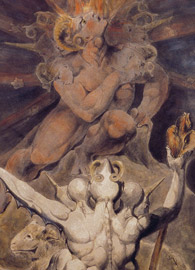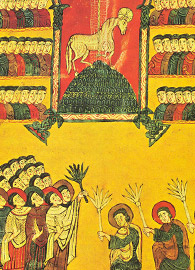Revelation Week 8
But God’s Victory Not Yet Realized on Earth (Revelation 12:18–15:4)
By Rob Wall
Seattle Pacific University Paul T. Walls Professor of Scripture and Wesleyan Studies
Read this week’s Scripture: Revelation 12:18–15:4
21:41
Podcast read by Carla M. Wall

 Enlarge
Enlarge
The origin of the word “thug” is from The Thugees, a large, well-organized assassin cult found in India from the 14th to 19th centuries. Its members, called “thugs” for short, infiltrated tourist caravans disguised as friendly co-travelers in order to put victims at ease before strangling them and stealing their goods. The Guinness Book of World Records credits them with two million murders. The British occupation successfully eradicated the cult from India by publishing reports of The Thugees’ existence to alert travelers to its deceptive methods. Knowledge of The Thugees destroyed the power of its deception. Revelation brings people knowledge of God that forms a powerful understanding of truth, not only about God but also about the world in which we live. John’s flashback of God’s victory over the evil one (Revelation 12:10–12), already cued by the exalted Son’s homecoming (12:5) and the ensuing war in heaven (12:7–9), prepares readers for the terrifying vision of “What now?” We are told without much fuss or fanfare that the devil’s defeat and demotion from heaven to earth have made him furious, not only because he lost his heavenly status (and decisively so) but also because he knows “he only has a short time” left to unsettle God’s plan of salvation before the Lord’s return to complete his mission (12:12). The devil’s current target is the woman’s “children […] who keep God’s commandments and hold firmly to the witness of Jesus” (12:17) — an image of today’s church.
The Antichrist and His Unholy Trinity
John now sees the devil standing on earth’s seashore (12:18), a fierce but defeated foe without anything more to lose, ready to make war against God’s people one last time. (Spoiler alert: the result is the same on earth as it was in heaven!) And so begins John’s vision of the present moment in the history of God’s salvation. It is fitting that the evil one is drawn to the sea, since in this apocalyptic world the sea is home to evil and so is an appropriate resource from which to draw allies skilled at violence and injustice. Two beasts are noted in particular, one from the sea and another from the land to form an unholy trinity. Together they rule over earth’s anti-God kingdom in which the woman’s faithful children (i.e., today’s church) live.
If the devil is an evil parody of the first person of the Holy Trinity, the beast he recruits from the sea parodies the second person (13:1–10). As we would expect, the first two persons of this unholy trinity are one; they bear a striking family resemblance (cf. 12:3 and 13:1). John also recognizes this beast in the light of Daniel’s vision of four beasts, which represent the four anti-God kingdoms of his world (cf. Daniel 7:1–8). Bits and pieces of those four beasts fill out the picture of the antichrist that John draws for us. But the seven heads, the total number of those on Daniel’s beasts, now wear crowns, symbolic of kings rather than kingdoms. The prophet recognizes that kingdoms are personified by their rulers, whether Roman Caesars or American presidents; even though the structures and institutions of their nation-states shape the opposition to the practices of God’s reign, these crowned (or elected) individuals are vested with “power, throne, and great authority” (Revelation 13:2) to give direction that shapes the people and places under their rule. Evil rulers beget kingdoms that practice evil (think Game of Thrones).
Likewise, the faithfulness of a single king, Christ Jesus, results in the triumph of God’s reign of grace (cf. Romans 5:18–21). Perhaps for this reason John at last recognizes the powerful beast as an “anti-Christ” — a parody of God’s paschal Lamb who also was “slain and killed” and whose “deadly wound was healed” (Revelation 13:3; 5:6). [Author’s Note 1] The result is the global deification of both dragon and beast (13:3b–4), adorned with “blasphemous names” given them by their worshipers (13:1). This image, of course, is full of irony since their act of worship, rooted in unbelief and ignorance of God (see 9:20–21; cf. 13:8), mistakes who really controls earth’s destiny: the Almighty One who sits on heaven’s throne and the messianic Lamb — a very different kind of slain beast — who stands beside it. But it also suggests that the failure to repent and turn to God has the consequence of supporting, even worshiping, those in charge of the political and social institutions opposed to the redemptive purposes of God.
The catalog of brutal practices the evil beast is authorized to perform (13:5–7) offers a razor-sharp contrast to the redemptive practices of the faithful Lamb. Yet John hints at a divine purpose behind the beast’s madness: the beast’s lies and use of violence to bring submission to his rule of evil occasion a time of spiritual testing when those faithful to the gospel should expect to suffer and even die (13:8–10). The present age on earth remains evil and the forces of evil, now in closer proximity with the devil thrown down to earth, seem to be in charge. The response of God’s people called for by Revelation is not to take up arms in retaliation but to face up to the reality of the present moment: to resist is futile (13:10) but also unnecessary since “the salvation and power and kingdom of our God [not the dragon], and the authority of his Christ [not the beast] have come” (12:10). [Author’s Note 2]
A second monster emerges from the polluted land to complete this unholy trinity. Called elsewhere “the false prophet” (16:13; 19:20; 20:10), its “priestly” role is to direct the global worship of the other beast (13:12). The idiom of its various malevolent activities (all stated in present tense) — to exercise the authority of the first beast (13:12), to make fire to come down from heaven (13:13), to give breath that animates the beast’s image (13:15) — parody the Spirit’s work on Christ’s behalf. The purpose of Revelation’s parody of God is to underscore the earlier claim that the evil one’s work is to deceive the whole world (12:9). Evil works its magic by convincing people that falsehood is truth, what is bad is really good for you, God is not good, and there is salvation in something other than the Lamb. Deception, especially when the beast and its henchman open their mouths to speak blasphemies against God (13:6), is the principal instrument in the devil’s toolbox.
The Antichrist’s Losing Battle
But the impression shaped by John’s vision is of the effectiveness and pervasiveness of evil’s reign. The unholy trinity seems to be in charge. Evil is winning, its deceptions are easily believed, and God’s ways are marginalized and even removed from the public square. And this deadly pair of beasts leaves no wiggle room, so that everyone is forced to submit and be marked as belonging to the beast’s people (13:16); their very survival depends upon it (13:17). If God’s people are not for them, they are against them; and if God’s people are against them, they are either led into exile (where their voices are no longer heard) or killed by the sword (13:10). Present tense. Right now.
No other figure in Revelation has attracted readers to it as much as the first beast, the antichrist. No feature of its description is more familiar than the “number of its name”: 666 (13:17b–18). The name belongs to a human (13:18), doubtless someone wearing a crown. Calibrations of this number to identify this ruler, mostly based upon what its first audience may have understood by it (and the calibrations proposed over the centuries are many), are futile investigations. The wisdom John calls for to understand this number is framed by his visionary world, not our own. The beast is not Nero, nor is it President Obama.
More simply, 6–6–6 falls short of 7, the symbol for a heavenly sense of completion, three times over. In William Hendrickson’s nice phrase, the end result of all the evil sponsored by those in charge of the present kingdoms of the world, their authority secured by deception and violence, is “failure upon failure upon failure.” [Author’s Note 3] We must never lose sight that the war between good and evil has already been waged and won on the cross!
Soldiers of the Lamb’s Army

 Enlarge
Enlarge
The stirring vision of the 144,000 saints (for the symbolism of this number see Lectio 5 on Revelation 7:1–4), now standing with the Lamb on Mount Zion (14:1), must be understood in connection to the previous vision of the oppressive regime of the two beasts. If Revelation 12:1–12 is a flashback from today that centers us on the heavenly victory of the exalted Christ, 14:1–5 looks forward to God’s final battle on earth against death and evil. This literary “sandwich” makes it perfectly clear that today’s reign of terror, described between, is but for “a short time” (12:12).
Richard Bauckham understands, then, that this is a scene of holy war, with each army identified by the tattoos on their foreheads (cf. 13:16–17; 14:1). [Author’s Note 4] Mount Zion, where the Lamb’s forces muster for battle, is where David built Jerusalem, the holy city. It is the place where God brings to fulfillment the promises made to God’s people. This is holy war that finally and fully will bring to realization God’s promise to repair and restore creation on earth as it already has been realized in heaven.
The battle song of the Messiah’s forces, sung with harp accompaniment in front of heaven’s throne, is “a new song” (14:3). Its lyrics undoubtedly reprise those of the “new song” sung in heaven when the worthy Lamb took the inscrolled plan of salvation from God’s hand and began to open its seven seals so as to publish its glad tidings of great joy (see Lectio 4 on 5:9–10). It is a song of salvation sung by those “purchased from the earth” (14:3), because it is they who testify to the efficacy of the Lamb’s shed blood that cleanses them from sin for service of a holy God (cf. 7:14–15).
For this moment, however, these saints are envisioned as soldiers of the Lamb’s army. Saints prepare themselves for holy war by abstaining from sex (14:4; cf. 1 Samuel 21:5–6) — we should assume the “women” in this case are Revelation’s two evil women, Jezebel (Revelation 2:20) and Babylon’s prostitute (17:1–2) — and by intently following the Lamb wherever he goes (even to death). This verb “to follow,” the key act of discipleship, is its only use outside of the Gospels and Acts. In this case, to follow Jesus includes confessing the truth about him (cf. 1 John 2:22–23; 4:15) and “blameless[ly]” (Revelation 14:5) following his moral example. [Author’s Note 5]
Readers of Revelation already know the outcome of this holy war. Heavenly voices, which have inside information and cosmic eyesight, have already celebrated God’s victory over the destroyers of earth (read again 11:17–19; 12:10–12). What follows in 14:6–20, then, elaborates what we already know. In fact, the messages brought by the triad of angels (three symbolizes a real deal) are entirely positive.
Three Signs of Good News
Perhaps you’ve seen airplanes dragging signs behind them advertising new products or announcing marriage proposals. This is what the angel is doing in 14:6 — the sign it flies high regards “eternal good news,” which is that God’s hour of judgment has arrived (14:7). A second angel iterates that Babylon has fallen (14:8). The verbal tense sets this in the past. The good news is not about the future of God’s judgment, but that it already has occurred. The real deal is a done deal.
“Babylon” is a well-known biblical typology used in Revelation of all those anti-God kingdoms of the world. Its precedent, of course, is the Babylon that is associated with Israel’s captivity, and more importantly with exiled Israel’s return to Jerusalem prophesied by Isaiah (Isaiah 40–66). The images of God’s harsh judgment of Babylon, revealed in history by its loss of political and economic power, correspond with Israel’s new exodus out of captivity and revitalization back home in the Promised Land (cf. Ezra–Nehemiah). Allusions to God’s fiery destruction of Sodom and Gomorrah (14:10–11) recall at the same time God’s faithfulness to promises made to Sarah and Abraham (cf. Genesis 19:24). Revelation uses these terrifying images of destruction and painful suffering to proclaim good news — not because it glories in the invincible anger of God, but because these are images that Scripture always links with a God at work to fulfill promises made to God’s people.
The right response to this vision of “eternal good news” is not quivering fear in the face of an angry God but endurance to the end when the promise of shalom is realized (Revelation 14:12–13). Moreover, the community’s endurance in response to the beast’s harsh treatment (13:10) is never passive — a fearful waiting for the end to come. Rather, the real Church is engaged in proactive “labors” (14:13) that involve a radical discipleship that “follow[s] the Lamb wherever he goes” (14:4).
John related the message of the angels to the nations to repent because the “hour” of God’s judgment has come (14:7). He now predicts this terrifying “hour” by a vision of two harvests gleaned by the returning Christ (14:14) and his angels, all of whom wield “sharp sickle[s]” swung over the “vineyard of the earth” (14:15–20). One sweep, a single judgment. But the biblical image of reaping a harvest or of gathering grapes to mash and ferment into good wine is not only the image of divine judgment but also of mission (cf. Matthew 9:37–38; Mark 4:29; John 4:36). There are, in effect, two harvests envisioned by John: one for judgment and the other for salvation; the two should never be separated. The gruesome prospect of God’s judgment of the nations should be preached as the “eternal good news” (Revelation 14:6). Christ died to end bad news, and this is bad news for any agent of bad news. This news should be published in unvarnished ways. But our proclamation of God’s defeat of evil is the means to a larger mission: to prepare the nations for their repentance in order that God may include them in the coming salvation. God’s final word is never a “no” but always a “yes.”
Revelation works with threes. Just as architects use triads to build firm foundations, John uses triads to symbolize what truly is true. In this case 15:1 tells us that the prophet sees a third celestial sign that concludes his vision of the present age, characterized as a battle between the woman (i.e., the church) and the evil one (see 12:1–3). The woman wins.
While John first sees seven angels who soon will bring bowls of plagues to pour upon earth (see 15:5–16:21), what captures his attention is a “sea of glass mixed with fire” (cf. 4:6) with the conquering army (144,000?) lined up along its shore (15:2). And they are singing. Again. Not the words of a “new song” as before (14:3), but of an old song — the “song of Moses” (15:3; cf. Exodus 15:1–18; Deuteronomy 32), which has been revised as “the song of the Lamb” (15:3). The Old Testament background of Moses’ song testifies to the faithfulness of God to promises made even though Israel failed to keep its covenant obligations (see Deuteronomy 31:14–29). But what stands at the center of Deuteronomy’s edition of the song of Moses, which is picked up by John, is the global scope of God’s judgment and salvation (Deuteronomy 31:1–8). Here too is where the songs of the Lamb and Moses intersect most clearly: the Lamb has cleared the way for the nations finally to make their way to God in doxology and worship.
Questions for Further Reflection
- How can God’s angry judgment and destruction come from a God of grace and love?
- What damage can the beast do now if we know the final victory belongs to God and the Lamb?
- What does service to God actually look like while the unholy trinity is exerting sway over the earth?
<<Previous Lectio Back to Revelation Next Lectio>>

This work is licensed under a Creative Commons License.




